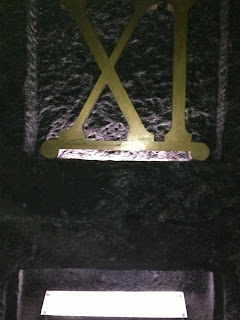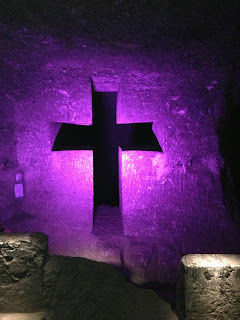Here are some pictures of the school and neighborhood outside the gates.
From outside the north gate and view of the houses on the street:



Below is inside the north gate; the red brick building on the right has a small apartment inside and I'm told I will be moving into there after the German exchange teacher leaves. I'm not sure when that will be and I'm actually quite content staying with the sisters, although I believe they have me set up in what is otherwise their TV room as there are 2 couches and chair on the other side of the room.


Fruit trees which provided us two papayas last week:

The Chapel and morning prayers and daily readings lead by Sister Carmen Alicia, the director:


Sister Maria Orozco in front of the convent (upstairs), the library (bottom left), and administrative offices (bottom right). My room is to the right of the balcony and the room beyond that is where the sisters have a computer, tv, and do their sewing and ironing.

I have to say that since I've been here I started ironing my pants which is the first time in probably 6 years. Mostly due to the fact that I have to hand-wash my clothes and they are terribly wrinkled from wringing them out. Here's a picture from my 2nd day here doing laundry from my time in Colombia. I couldn't believe how hard it was and I was completely exhausted afterwards! I've since learned to try my best to not get clothes dirty and to wash a little at a time. And since I'm south of the equator, it's true that water drains counter-clockwise and here's a video I took to prove it. :)

Back to the school...here's one of 3 basketball courts and beyond that is the soccer field where I've started running around in the evenings when it cools off. You can barely make out the hill/mountain in the background above the blue bleachers and that's due to the smog here.


There are many classroom buildings:





Another court and stage on the west side:


The restrooms:

View of the south gate within the school grounds:

Outside the south gate and the street view:



Being in the southern hemisphere, it's summer right now and the weather has lately been averaging 80 degrees with mild humidity, but when I first got here, it was 90 and felt like 100. I heard about the school closings in Michigan this morning from snow, so it's definitely different here.
The school year goes from March 1 until the middle of December. The teachers arrived back to school last week and have been preparing for the upcoming school year and attending seminars organized by Sister Carmen Alicia, the director/principal. I will be a teacher's aide from what I gather, but I'm not sure if I will be working with one or all of the five english teachers here. I have been spending most of my time trying to learn spanish and one of the english teachers has been asked to help me with this about 30-60 minutes a day. I study on my own using Duolingo and list questions to later review with Jennifer, the english teacher. I'm definitely getting better and understanding more, but it's still slow going and I'm grateful the sisters have been giving me plenty of time to study as well as practicing with me. Conversations require a lot of patience on both sides!
The meals are much different here than at the school in Colombia. The sisters eat very little and I'm doing my best to follow suit. I did pack some almonds and a few granola bars that I try hard to resist eating since I know I have over two more months to go. For breakfast we typically have a hard roll, sometimes cheese or a hard boiled egg, and a small bowl of fruit. Lunch is my favorite part of the day (followed by una siesta!) and consists of soup (mostly with chicken feet, carrots, onions, celery); main dishes include potatoes; green platanos (large, less sweet bananas); small amount of chicken or beef; broccoli, spinach, or some other green; and rice. Dinner has lately been a banana. I'm not "starving," but I do scrap every crumb off the plate.
The other day I helped with lunch by pealing dried potatoes that had sat in water overnight. These potatoes, called chuño, are an ancient custom of the Incas of basically freeze-drying them and allows the potatoes to be stored for a year. The process involves leaving the potatoes outside overnight to freeze, then the water evaporates throughout the next day under the heat of the sun; this is continued for several days until you have dried potatoes that look like rocks or stones. To later cook, you soak in water and then peal the potato skin off. It looks and feels more like a brown mushroom. You boil the potatoes for a few minutes and they are ready to eat. I tried a few and while I'm more than happy to help prepare them, I think I'll be leaving off my plate next time (proof again I'm not that desperate for food).


Stephani lives here also, but works outside Lima for another poor community. I went with her the other day to her work and it was like a community center with a park and doctors office. I'm not 100% sure, but I think she is a physical therapist. When she's not working here, she helps the sisters out with cooking and cleaning.

Beef and potato stew, the Chuños, soup, and steamed platanos:

The other night, Sister Deysi (pronounced Daisy) surprised me with a delicious dinner...a cheese omelet with applesauce on top. What a treat that was!

Back to studying now! I am going into Lima tomorrow with the english teachers so I will update again when I can. ¡Adiós! ¡Chau!













































